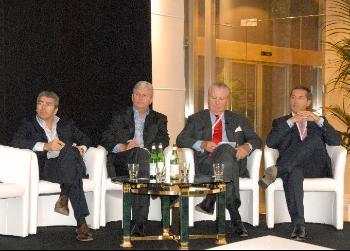5th International Hotel Conference in Rome - expansion and trends
Rome (October 26, 2007). This year, the hotel industry world wide will see increased room yield (RevPar). At the same time, the number of hotels in planning and construction will continue to rise on all continents. The never ending discussions surrounding the chronic shortages of personnel thus take on new significance, as talks at the 5th International Hotel Conference (IHC) in Rome last week all too closely showed. Nevertheless, the hotels contributing to podium discussions didn't exactly make the impression that they were actively doing too much about it. Creativity is also needed with respect to "niche discovery". Ideas are in abundance, it's the courage to implement them that's lacking. Over 400 participants met for casual networking in Rome as increasingly the IHC makes its name as the pleasant counterpart to the empty International Hotel Investment Conference in Berlin in March.
The participants at the conference are certainly no less competent, though the impression they make when giving their responses is certainly much less smug and they seem a tick more honest than their counterparts in the sponsored event in Berlin. Morris Lasky, the American organiser of the Hotel Conference in Rome, finances the IHC through sponsorship, though doesn't fill the rounds exclusively with sponsor partners. In Rome, with its 400 participants (as opposed to the 1,200 in Berlin last March), the whole event is a little more manageable. Additionally, the more varied, relaxed discussion format (plenum, workshops, round tables) allow room for more practice relevant discussions in smaller groups. Here's a selection from the many sessions and statements:

The opening session (from left): Giorgio Boscolo,
CEO Boscolo Group; Hans W.R. Kennedie, CEO Golden
Tulip Hospitality Group; Paul M. McManus, CEO
The Leading Hotels of the World; Scott Woroch,
Executive Vice President Business
Development Four Seasons Hotels & Resorts.
Endless expansion - the hotel world in figures. Pat Ford, President of the internationally respected hotel property data base Lodging Econometrics presented figures for European hotel projects published last week (see link) and compared these across continents. Europe is the continent in which most hotels are still in the pipeline: 814 projects with 139,133 rooms, followed by the Middle East with 457 projects and 133,853 rooms and by Africa with 138 projects and 26,085 rooms. Worldwide, most projects are to be found in the USA (611,341 rooms in 4,638 hotels) and in Asia (366,679 rooms in 1,555 hotels). Within Europe itself, most hotels are being built in Great Britain (277 projects) followed by Spain (96), Germany (61), Russia, Italy and France.
Global increase in RevPar in 2007. Marvin Rust, Managing Partner of Hospitality Deloitte, placed expected RevPar in the international context: Europe is "RevPar King". Between 2003 and 2007, values rose to 115 USD, followed by the Asian Pacific with 103 USD and the Middle East 99 USD. Positive developments began at different times though - firstly in the USA then in the Middle East (starting 2003), followed by Asia and Europe in the same year (2004), although the non-EU countries showed greater RevPar growth than the EU countries.
Trends from the world of finance. The enthusiasm for residences is growing across the globe; even in the leisure sector, more and more timeshare complexes are being changed into residences. Hotels are increasingly often incorporated into mixed use units, a trend clearly demonstrated by the mega developments in Las Vegas, Singapore and Macao: The hotel loses its "stand alone" function and in return becomes (more) affordable to investors on account of the relatively low land costs.
Hotel categories - which are set to grow? This question brought in lots of answers; interesting was that two of the above mentioned speakers referred to attractive family resorts, either in the countryside or in cities (family city resorts). Also, more prevalent thinking seems to be going on with respect to small and the smallest target groups: The culture traveller, for instance, should in future be able to find a hotel in the museum, the teenage traveller a "fun hotel" with disco (what needn't necessarily be the same thing as a low budget hotel), pilgrim travellers religion orientated hotels and women hotels specially adapted to the needs of women... Giorgio Boscolo added rightly: Needed are not only new hotel types but consistently orientated new hotel types!
Human Resources - all talk and not enough action. Paul McManus, CEO of Leading Hotels of the World described the branches efforts up until now with regard to training and further training as pathetic and challenged hoteliers no longer to offer jobs but career opportunities. Four Seasons is already doing exactly this, though still struggles with personnel shortages in some regions, for instance in China, where the Group hasn't been able to find enough Mandarin speaking staff, as Scott Woroch, Executive Vice President Business Development explained. Giorgio Boscolo, CEO of the group by the same name in Italy, would like to see the hotel industry sell itself as a "sexy" branch, a suggestion which Hans W.R Kennedie, CEO of Golden Tulip Hospitality Group quickly took up with the idea that restaurants, for instance, should no longer serve food and drink for longer, but should implement new and attractive concepts with which staff could identify emotionally. Common complaint among all participants was the lack of patience showed by the younger generation with respect to climbing the career ladder. Similar comments came from other speakers in previous years. Disappointing for the audience was that this time too the discussion remained theoretical and that no one presented a motivating human resource success story from practice.
Spa & Wellness - The USA and Europe draw closer. American spa-planners calculate spas right from the very beginning in terms of profitability. All the same: "Most US spas don't run at profit," Glenn Colarossi added, President of the Consulting and Management Company by the same name. And this experience is set to become all the more prevalent as US spas increasingly assume European "experience" character and are beginning to place more emphasis on ambience. In the opinion of the second American in the spa think tank, Chris White, Senior Vice President of the planning and design company WTS International, there is also the trend in the USA to extend relaxation spaces. From both sides of the ocean came the positive report: With respect to treatments, authentic applications are most popular - gimmicks such as the chocolate bath, the coffee pack or the caviar mask are out!
Karin Leeb, owner of the Hochschober Hotel in Austria, and Susanne Frase, spa consultant und manager of the German destination resort Fleesensee championed a smaller but better quality "spa menu", which would offer original treatments and then certain other special treatments unique only to the particular spa (so-called "signature treatments"). Heinz Schletterer, CEO of the Austrian design company by the same name, summarised the current trends in Europe. He sees good chances for highly specialised niche spas, for instance, for children, sportsmen and women, day guests, but also for the medical spas.
hospitalityInside.com will report on further trends and statements in coming weeks. / map
To print this article you have to be registered and logged in for newsletter, visitor or subscription.





